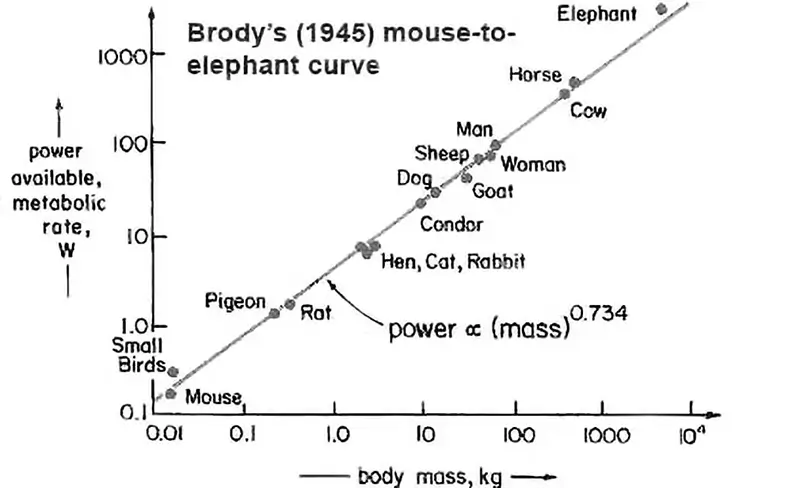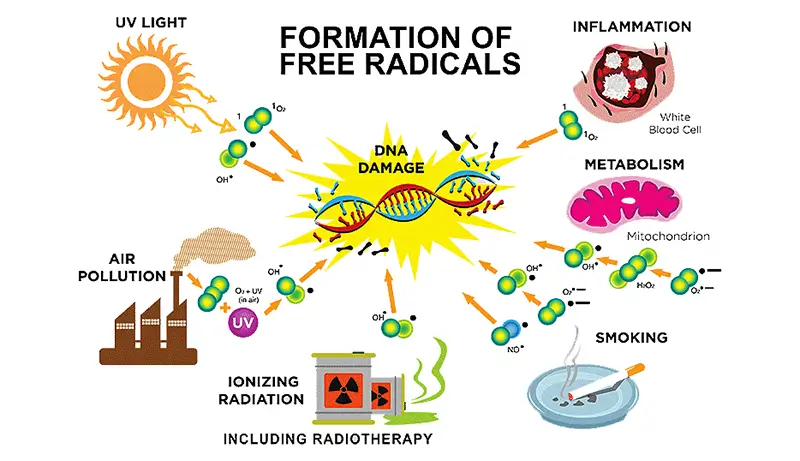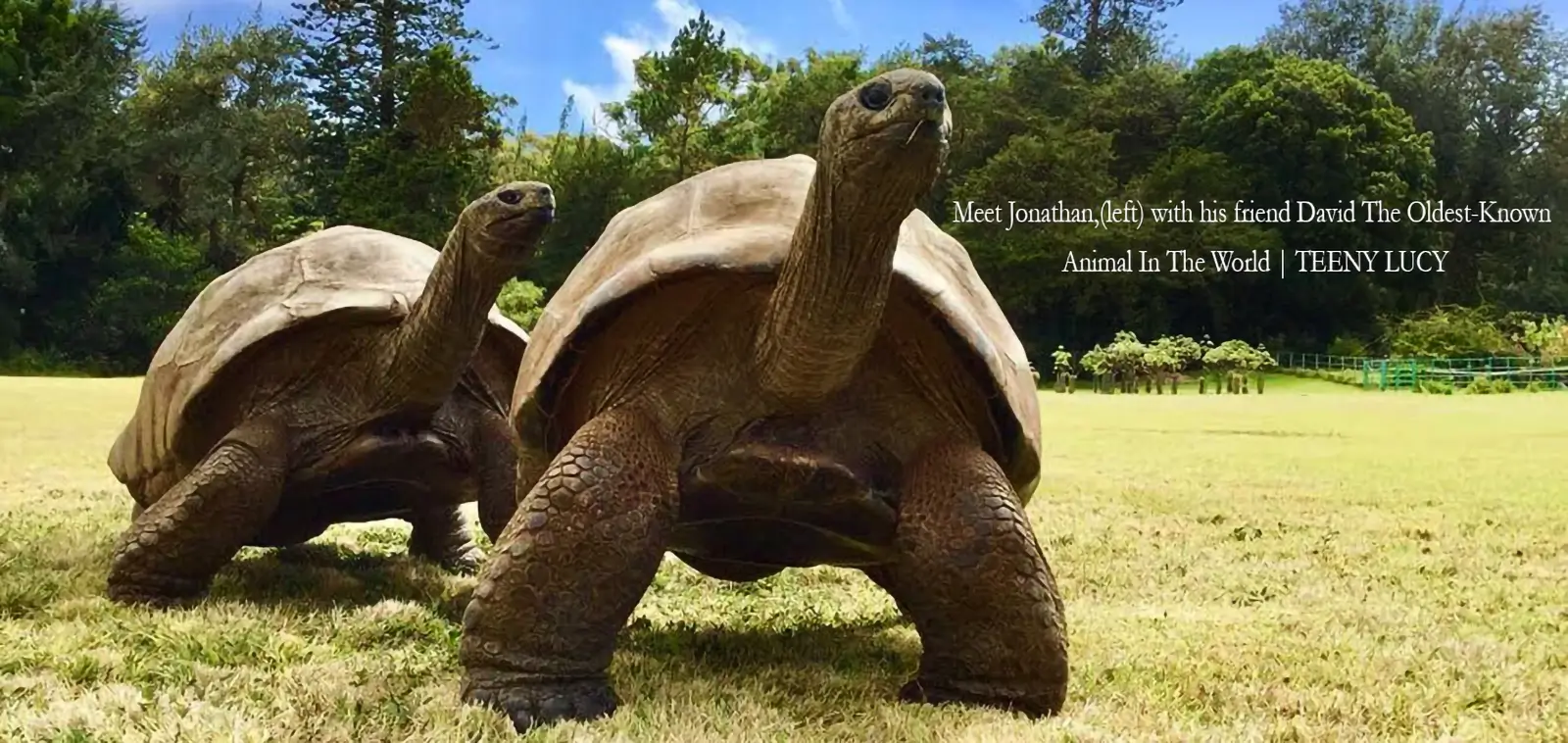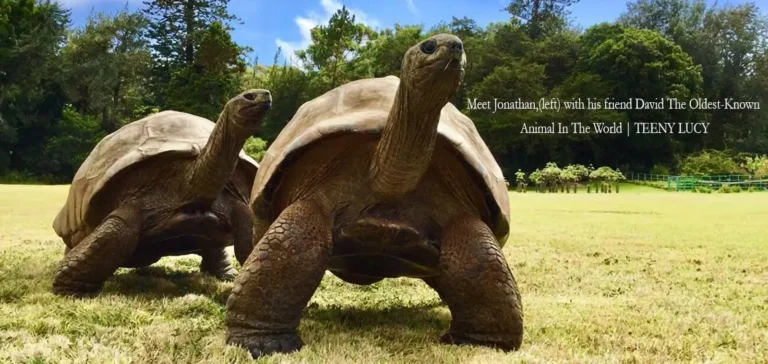Intermittent Fasting vs Calorie Restriction- Is there a difference?
There is a form of diet that is primarily designed for utilizing autophagy called intermittent fasting. To do a full-calorie restriction diet is a hard choice.
Milos Pokimica
Written By: Milos Pokimica
Medically Reviewed by: Dr. Xiùying Wáng, M.D.
Updated June 9, 2023There is a form of diet that is not related to weight loss primarily. Even some bodybuilders appear to try it. It is a diet primarily designed for utilizing autophagy called intermittent fasting.
What they try to do is to limit the intake of calories by 4 to 8 hours a day. So the rest of the time there will be fasting to tap into this mode of healing. However, there will not cut on the calories they will be just consuming them for a restricted period.
Some studies show that this too can have beneficial effects. There is truth in the statement that meal frequency is not nearly as important as the quantity and quality of food consumed. Thus logically if we still eat all of our calories in the period of 4 hours and are active the rest of the time, it is still unlikely that we will burn all of our glycogen stores because we replenish them every day.
In that sense, intermitting fasting would not be able to tap into the same healing mechanism at the level of calorie restriction. If we eat less and go into calorie restriction, it does not matter because we will be in deficit no matter when we eat. It will be a good idea to put exercise on a regimen of intermittent fasting just before the end of the fast, to deplete the glycogen stores, or we can combine all three methods. Calorie restriction with intermittent fasting with physical activity.
To go around this, there is Alternate day fasting (ADF). It involves a 24-hour fast followed by a 24-hour non-fasting period. Then there are whole-day fasting cycles that specify various ratios of fasting to non-fasting days, such as the 5:2 diet. You eat for five days, then fast on water or vegetable juices for two. So far studies done on animal models have shown that fasting improves indicators of health like blood pressure, insulin sensitivity, and inflammation.
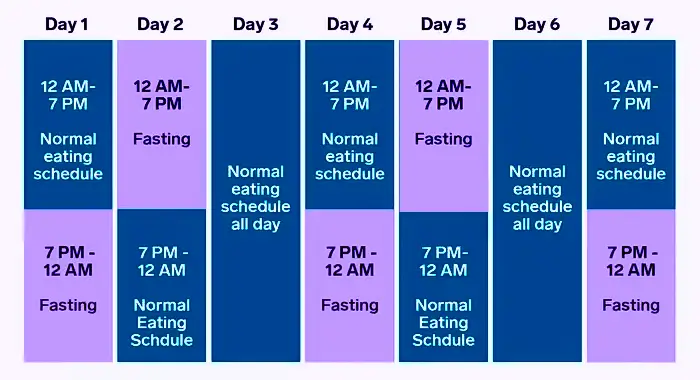
Intermittent fasting in my personal view started as a convenient way to do a calorie-restricted diet. To do a full-calorie restriction diet is a hard choice. Most of the population will not do it. The intermittent fasting line is to go and fast 1 or 2 days a week and clean our cells, reset our metabolism to take control of our hunger cravings, and so on. That will help our body to go into autophagy and high HGH levels and will start the healing mechanisms.
However, there is another essential benefit of calorie restriction, and that is lowering the basal metabolic rate. If we have a car with a million horsepower, it will burn a gallon of fuel in a millisecond, but if we have a car that runs on one horsepower, it will go much longer. It is called efficiency. When you force yourself to become more efficient in burning energy you go longer.
Calorie restriction is not calorie restriction our entire life. It is the only restriction in the beginning period. Our physiology will adapt to hunger to some extent by becoming more efficient with the calories that it has. Basal metabolic rate has the ability to slow down, but only to some extent. Our body will enter the starvation response and will go through the physiological changes that reduce metabolism in response to a lacking of food. The human body has some level of ability to adapt and structure itself known as deprivation response (i.e., metabolic adaptation).
There was a study done on eight individuals living in isolation in Biosphere 2. Biosphere 2 is an Earth Systems science research facility located in Oracle, Arizona. It was initially designed to determine the viability of closed ecological systems to support human life in outer space. The first experiment was conducted on eight individuals for two years. After the experiment was finished, the metabolic rate of these eight isolated individuals was measured and compared with a control group that initially had similar physical characteristics. The starvation response managed to reduce the metabolic rate by 180 kcal on average in daily total energy expenditure.
If you eat regularly 2000 calories and you start to restrict the calories your metabolism slows down to 1800 calories on average. Then when you came back to eat these 1800 calories, it is not a restriction anymore. It is in a sense because you are at an artificially lowered metabolic rate so if you start overeating again your basal metabolic rate will go up, but if you stay at this level you will not starve and die. You can live in this new state. People have this kind of idea about the calorie restriction diet that you are restricted continuously. In a sense, you are because you operate at a lower metabolic rate, but you are not in the physical sense or you will eventually die. And that is the reason why calorie restriction prolongs life.
Slowing down metabolism means prolonging life through efficiency. Burning fuel means stress in the form of oxidative damage to the DNA that needs to be repaired.
Can you gain muscle on caloric restriction? Probably just some level of body recomposition. If you have some kilograms to lose then lowering by 400 calories can increase muscle and lower fat deposits at the same time if you do resistance training. But if you are already calorie-restricted at the optimal level then no, your body has already lowered your metabolism as much as it can. There is a calorie in calorie out equation based on the first law of thermodynamics. It might be possible on intermittent fasting cycles. Five days of resistance training than two days of aerobic training plus fasting.
One other thing. When we start building muscle our metabolism can slow down if we do not increase calories, it will adapt to some extent. We do not need to start overeating excessively just because we go to the gym. That will give you dirty bulk. One hundred grams of flesh have around 25 grams of protein and 150 calories, and you cannot grow at the rate of 100 grams of muscle mass a day. In my opinion, when we start resistance training, it would be wise to raise calorie consumption at the level of what is burned during the exercise plus a little more, at the top 200 calories more than that. Raising it higher is excess that goes into adipose tissue, basically the waste of energy that has to be burned at some point. Overeating with the excuse:” I go to the gym”, is not a good idea.
Conclusion:
- Without any pharmacological intervention, CR improves metabolic parameters, which will benefit especially pre-diabetic and insulin-resistant patients. Also increases longevity.
- IF without calorie restriction can improve health and cellular resistance to disease especially cancer, diabetes, and other DNA damage-induced conditions same as CR but without causing weight loss. This might be beneficial for individuals that want to preserve muscle mass.
The best option would be and you can do this also to combine both at the same time. If you want to go on a diet my recommendation is not just to cut calories but to limit the time period as well. This is what I do. In the obesity epidemic, if you do not incorporate these techniques into a regular regimen of life, the health risk correlations can have serious consequences.
References:
Passages selected from a book: Pokimica, Milos. Go Vegan? Review of Science Part 1. Kindle ed., Amazon, 2018.
- Mattson, Mark P et al. “Impact of intermittent fasting on health and disease processes.” Ageing research reviews vol. 39 (2017): 46-58. doi:10.1016/j.arr.2016.10.005
- Barnosky, Adrienne R et al. “Intermittent fasting vs daily calorie restriction for type 2 diabetes prevention: a review of human findings.” Translational research : the journal of laboratory and clinical medicine vol. 164,4 (2014): 302-11. doi:10.1016/j.trsl.2014.05.013
- Liu, Kai, et al. “Intermittent Fasting: What Questions Should We Be Asking?” Physiology & Behavior, vol. 218, Elsevier BV, May 2020, p. 112827. https://doi.org/10.1016/j.physbeh.2020.112827.
- Razavi, Roghaye et al. “The alternate-day fasting diet is a more effective approach than a calorie restriction diet on weight loss and hs-CRP levels.” International journal for vitamin and nutrition research. Internationale Zeitschrift fur Vitamin- und Ernahrungsforschung. Journal international de vitaminologie et de nutrition vol. 91,3-4 (2021): 242-250. doi:10.1024/0300-9831/a000623
- Aksungar, F B et al. “Comparison of Intermittent Fasting Versus Caloric Restriction in Obese Subjects: A Two Year Follow-Up.” The journal of nutrition, health & aging vol. 21,6 (2017): 681-685. doi:10.1007/s12603-016-0786-y
Related Posts
Do you have any questions about nutrition and health?
I would love to hear from you and answer them in my next post. I appreciate your input and opinion and I look forward to hearing from you soon. I also invite you to follow us on Facebook, Instagram, and Pinterest for more diet, nutrition, and health content. You can leave a comment there and connect with other health enthusiasts, share your tips and experiences, and get support and encouragement from our team and community.
I hope that this post was informative and enjoyable for you and that you are prepared to apply the insights you learned. If you found this post helpful, please share it with your friends and family who might also benefit from it. You never know who might need some guidance and support on their health journey.
– You Might Also Like –

Learn About Nutrition
Milos Pokimica is a doctor of natural medicine, clinical nutritionist, medical health and nutrition writer, and nutritional science advisor. Author of the book series Go Vegan? Review of Science, he also operates the natural health website GoVeganWay.com
Medical Disclaimer
GoVeganWay.com brings you reviews of the latest nutrition and health-related research. The information provided represents the personal opinion of the author and is not intended nor implied to be a substitute for professional medical advice, diagnosis, or treatment. The information provided is for informational purposes only and is not intended to serve as a substitute for the consultation, diagnosis, and/or medical treatment of a qualified physician or healthcare provider.NEVER DISREGARD PROFESSIONAL MEDICAL ADVICE OR DELAY SEEKING MEDICAL TREATMENT BECAUSE OF SOMETHING YOU HAVE READ ON OR ACCESSED THROUGH GoVeganWay.com
NEVER APPLY ANY LIFESTYLE CHANGES OR ANY CHANGES AT ALL AS A CONSEQUENCE OF SOMETHING YOU HAVE READ IN GoVeganWay.com BEFORE CONSULTING LICENCED MEDICAL PRACTITIONER.
In the event of a medical emergency, call a doctor or 911 immediately. GoVeganWay.com does not recommend or endorse any specific groups, organizations, tests, physicians, products, procedures, opinions, or other information that may be mentioned inside.
Editor Picks –
Milos Pokimica is a health and nutrition writer and nutritional science advisor. Author of the book series Go Vegan? Review of Science, he also operates the natural health website GoVeganWay.com
Latest Articles –
Top Health News — ScienceDaily
- MIT scientists strip cancer of its sugar shieldon December 23, 2025
Scientists at MIT and Stanford have unveiled a promising new way to help the immune system recognize and attack cancer cells more effectively. Their strategy targets a hidden “off switch” that tumors use to stay invisible to immune defenses—special sugar molecules on the cancer cell surface that suppress immune activity. Early tests show it can supercharge immune responses and outperform current antibody therapies.
- Scientists find a weak spot in deadly fungus that shut down hospital intensive care unitson December 23, 2025
A deadly hospital fungus that resists nearly every antifungal drug may have an unexpected weakness. Researchers discovered that Candida auris activates specific genes during infection to hunt for nutrients it needs to survive. This insight came from a new living-host model that allowed scientists to watch the fungus in action. The findings could eventually lead to new treatments or allow current drugs to be repurposed.
- This ultra-sensitive imaging system can spot cancer earlieron December 23, 2025
A new imaging technology can distinguish cancerous tissue from healthy cells by detecting ultra-weak light signals. It relies on nanoparticles that bind to tumor markers, making cancerous areas easier to identify. The system is far more sensitive than existing tools and could speed up cancer screening. Scientists believe it may help detect tumors earlier and reduce delays in diagnosis.
- Hidden brain maps that make empathy feel physicalon December 23, 2025
When we watch someone move, get injured, or express emotion, our brain doesn’t just see it—it partially feels it. Researchers found eight body-like maps in the visual cortex that organize what we see in the same way the brain organizes touch. These maps help us instantly understand actions, emotions, and intentions in others. The discovery sheds light on human empathy and opens doors for new brain-based therapies and AI systems that better understand the body.
- Are they really listening? Watch their blinkson December 23, 2025
Your eyes may reveal when your brain is working overtime. Researchers found that people blink less when trying to understand speech in noisy environments, especially during the most important moments. The effect stayed the same in bright or dark rooms, showing it’s driven by mental effort, not light. Blinking, it turns out, is a quiet marker of focused listening.
- This cancer-fighting molecule took 50 years to buildon December 22, 2025
MIT scientists have achieved the first-ever lab synthesis of verticillin A, a complex fungal compound discovered in 1970. Its delicate structure stalled chemists for decades, despite differing from related molecules by only two atoms. With the synthesis finally complete, researchers created new variants that showed strong activity against a rare pediatric brain cancer. The breakthrough could unlock an entire class of previously unreachable cancer-fighting molecules.
- A new drug could stop Alzheimer’s before memory loss beginson December 22, 2025
New research suggests Alzheimer’s may start far earlier than previously thought, driven by a hidden toxic protein in the brain. Scientists found that an experimental drug, NU-9, blocks this early damage in mice and reduces inflammation linked to disease progression. The treatment was given before symptoms appeared, targeting the disease at its earliest stage. Researchers say this approach could reshape how Alzheimer’s is prevented and treated.
PubMed, #vegan-diet –
- Comparing diet-related attitudes, perceptions, and behaviors of vegan and omnivorous adults: results from a cross-sectional survey study in Germanyon December 22, 2025
CONCLUSION: The findings are consistent with and build on existing research on cognitive and behavioral patterns related to a vegan diet, while at the same time yielding some additional insights. In particular, the results on significant differences in the risk-benefit perception of a vegan diet, as well as on motivations and influences regarding the decision to follow a vegan diet provide an important basis for the development of public health interventions and a foundation for further […]
- Assessment of vitamin A, vitamin B2, vitamin B12, vitamin K, folate, and choline status following 4 months of multinutrient supplementation in healthy vegans: a randomised,…on December 19, 2025
CONCLUSION: A multinutrient supplement containing 82 µg of vitamin B(12) per day significantly positively affected vitamin B(12) blood biomarkers in healthy vegans.
- Exploring the synergistic potential of pH and ultrasonication on the functional properties of pea and lentil protein isolates and its formulation in food producton December 15, 2025
The substitution of meat proteins with plant-based proteins from various sources is often motivated by nutritional considerations. However, the inherent limited solubility of plant proteins, which results in suboptimal techno-functional properties, remains a persistent challenge in food formulation. The purpose of this study was to utilize unique properties of pea (Pisum sativum L.) and lentil (Lens culinaris) through ultrasonication and pH variation in order to develop a stable and […]
- Healthful and Unhealthful Plant-Based Diets and Their Association with Cardiometabolic Targets in Women Diagnosed with Breast Cancer: A Cross-Sectional Analysis of a Lifestyle Trialon December 11, 2025
CONCLUSIONS: Maintaining cardiometabolic risk factors within normal ranges is clinically relevant in BCS, and this may be more likely when a plant-based diet is consumed, especially if low in unhealthy plant foods.
- Functional and Nutritional Properties of Lion’s Mane Mushrooms in Oat-Based Desserts for Dysphagia and Healthy Ageingon December 11, 2025
Hericium erinaceus (Lion’s Mane mushroom) is a medicinal species recognised for its neuroprotective and antioxidant properties. This study investigated its potential as a functional ingredient in oat milk-based desserts formulated for individuals with dysphagia. Freeze-dried Lion’s Mane powder (LMP), containing high-quality protein (~16%, amino acid score 88%), dietary fibre (~31%), and phenolic compounds (72.15 mg GAE/g), was incorporated at varying levels using gelatin or iota-carrageenan […]
Random Posts –
Featured Posts –
Latest from PubMed, #plant-based diet –
- Associations Between Healthy and Plant-Based Dietary Patterns and Cognitive Reserve: A Cross-Sectional Analysis of the 1946 British Birth Cohortby Kelly C Cara on December 23, 2025
CONCLUSIONS: CR was positively associated with healthy dietary patterns and inversely associated with unhealthful plant-based dietary patterns. Diet uniquely explained variations in CR and should be considered among influential lifestyle factors in future research. Longitudinal analyses are needed to confirm these findings.
- Dietary quercetagetin attenuates H2O2-induced oxidative damage and preserves meat quality in broilers by modulating redox status and Nrf2/ferroptosis signaling pathwayby Wenyue Hu on December 22, 2025
In modern poultry production, oxidative stress has emerged as a pivotal factor compromising the health status and overall performance of broiler. The aim of this study was to investigate the effects of dietary quercetagetin (QG) supplementation on hydrogen peroxide (H(2)O(2))-induced oxidative damage in breast muscle of broilers, focusing on growth performance, meat quality, and antioxidant function, and elucidating the underlying mechanisms. Two hundred and forty one-day-old Cobb broilers […]
- Effects of dietary selenium supplementation on physiological parameters, tissue fatty acid composition, and fatty acid-metabolism relative gene expression of grouper (Epinephelus coioides) fed high…by Yen-Chun Lee on December 22, 2025
The present study evaluated the effects of dietary selenium (Se) supplementation on growth performance, physiological responses, tissue fatty acid profiles, and the expression of genes related to fatty acid metabolism in juvenile grouper (Epinephelus coioides). A control diet based on soy protein concentrate, replacing 40% of the fish meal protein, was supplemented with graded levels of Se at 0, 0.3, 0.6, and 1.0 mg Se kg^(-1). A fish meal-based reference diet was also included for […]
- Unravelling the interaction between feeding regimens and milking time in Parmigiano Reggiano PDO milk: an integrated metabolomics and ion mobility lipidomics approachby Pier Paolo Becchi on December 22, 2025
In this study, an integrated approach based on UHPLC-HRMS metabolomics and IM-HRMS lipidomics has been carried out to unravel the interaction between feeding and milking time in the overall chemical profile of Parmigiano Reggiano (PR) milk. Specifically, ANOVA multiblock OPLS (AMOPLS) modelling revealed the complementarity of the assays in combining the effect of these two critical parameters. In particular, metabolomics highlighted the presence of plant-derived compounds (mainly terpenoids […]
- Comparing diet-related attitudes, perceptions, and behaviors of vegan and omnivorous adults: results from a cross-sectional survey study in Germanyby Dan Borzekowski on December 22, 2025
CONCLUSION: The findings are consistent with and build on existing research on cognitive and behavioral patterns related to a vegan diet, while at the same time yielding some additional insights. In particular, the results on significant differences in the risk-benefit perception of a vegan diet, as well as on motivations and influences regarding the decision to follow a vegan diet provide an important basis for the development of public health interventions and a foundation for further […]
- The effect of dietary interventions on peripheral markers of inflammation among people with multiple sclerosis: A systematic review and meta-analysis of randomized controlled trialsby Wade R Pingel on December 21, 2025
CONCLUSIONS: Several dietary interventions may reduce systemic inflammation in PwMS, with greater effects in longer-duration interventions. Calorie-restricted diets did not significantly alter adipokines. Given the limited number and heterogeneity of studies, larger and longer RCTs using comparable dietary interventions are needed to confirm these findings.
